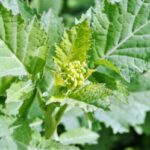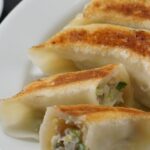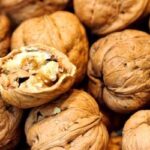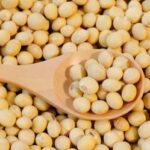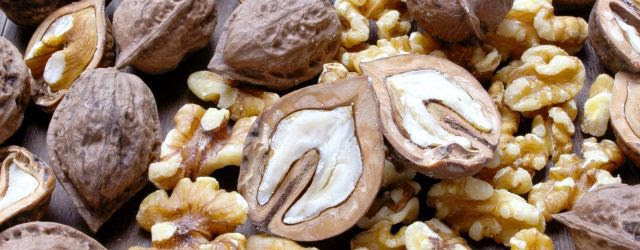
At the 67th Consumer Commission Food Labeling Section Meeting held on June 6, 2022, the prospect of the mandatory allergen labeling of “walnuts” was announced. I would also like to take up the “Report on the national fact-finding survey of health damage caused by immediate-type food allergy in 2021”, which was the background of the announcement.
Main Points
- According to the survey (2020), nuts have become one of the three major foods causing allergies, surpassing wheat
- Among nuts, allergens caused by walnuts have increased significantly, followed by cashew nuts
- The revision bill to make walnuts subject to mandatory labeling is expected to be consulted by the end of this fiscal year
Background to date
It was at the 56th Consumer Commission Food Labeling Section Meeting held on July 5, 2019, that the Consumer Affairs Agency (CAA) announced its policy of “designating walnuts as products subject to mandatory labeling.” The background is that the number of cases caused by almonds and walnuts increased compared with the previous two surveys in the report compiling the results of the survey at that time (“Report on the national fact-finding survey of health damage caused by immediate-type food allergy in 2018”).
Subsequently, almonds were added to the list of items for recommended allergen labeling in September 2019. As for walnuts, the issues to be considered were organized as follows, -need to confirm whether or not the number of cases is not just temporary
-when designating an item as subject to mandatory labeling, test methods need to be developed and validated from the perspective of ensuring the implementation.
In addition, the “Advisors’ Meeting on Food Allergen” which started in February 2021, proceeded with preparations and discussions, including surveys.
Based on the results of the survey, a concrete target (aiming for consultation by the end of this fiscal year) was set regarding the timing of the transition of walnuts to a mandatory labeling item.
About this survey
The following is an excerpt from the 67th Food Labeling Section Meeting material, “Regarding labeling of foods containing allergens”, which provides an overview of the survey.
Method of the surveys
- The subjects of the survey were “Patients who had any reaction within 60 minutes of food ingestion and visited a medical institution” except the cases in which symptoms were induced by food oral load testing or oral immunotherapy (OIT).
- The survey period was from January to December 2020, and postcards were mailed every three months. Reports were received by postcard or by email when requested.
Subject of the survey
6,080 cases were analyzed after excluding 414 cases with unidentified causative substances, 83 cases with causative substances other than food (70 cases of Anisakis, 13 cases of mite), and 100 cases with unclear age, gender, treatment/outcome, first-time cases of allergy/ erroneous food intake, and OIT out of a total of 6,677 cases.
Causative food
Chicken eggs 2,028 cases (33.4%), cow milk 1,131 cases (18.6%), and nuts 819 cases (13.5%). Until the previous survey, the top three causative foods were chicken eggs, cow milk, and wheat, but in this survey, the proportion of nuts increased to third place (from 8.2% in the previous survey to fourth place). Among the nuts, walnuts were the largest number (463 cases), followed by cashew nuts (174 cases) and macadamia nuts (45 cases).
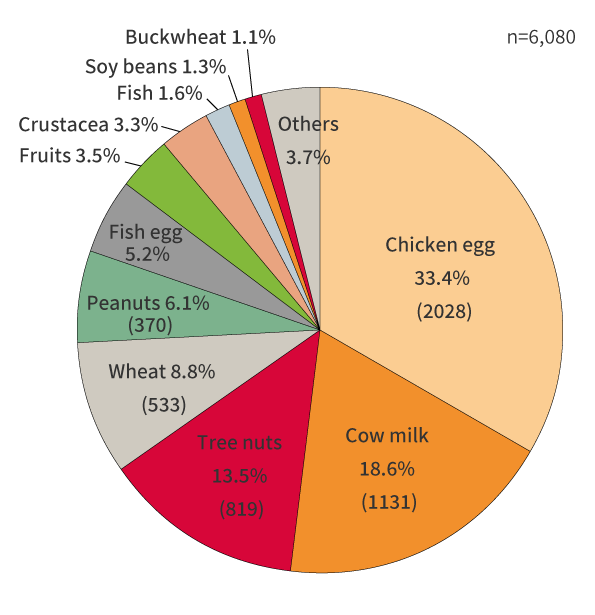
| Type | n | % of total |
|---|---|---|
| Walnuts | 463 | 7.6% |
| Cashew nuts | 174 | 2.9% |
| Macadamia nuts | 45 | 0.7% |
| Almonds | 34 | 0.6% |
| Pistachios | 22 | 0.4% |
| Pecan nuts | 19 | 0.3% |
| Hazelnuts | 17 | 0.3% |
| Coconuts | 8 | 0.1% |
| Cacao | 1 | 0.0% |
| Chestnuts | 1 | 0.0% |
| Pine nuts | 1 | 0.0% |
| Mixed nuts/category unknown | 34 | 0.6% |
| Total | 819 | |
Table1: Breakdown of tree nuts
Shock symptoms
Until the previous survey, the top three causative foods causing shock symptoms were chicken eggs, cow milk, and wheat, but in this survey, the proportion of nuts increased to third place (from 12.8% in the previous survey, the fourth place). As the breakdown of the nuts, walnuts were the most common at 58 examples, ranking higher than peanuts (46 cases) alone. Cashew nuts followed with 30 cases.
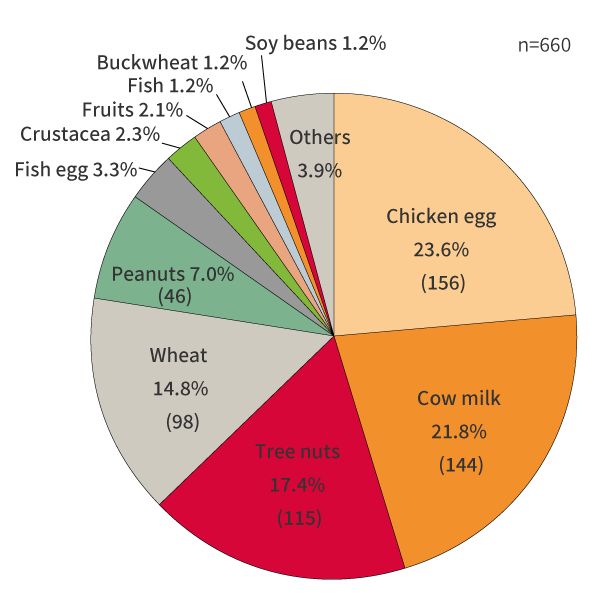
| Type | n | % of total |
|---|---|---|
| Walnuts | 58 | 8.8% |
| Cashew nuts | 30 | 4.5% |
| Almonds | 7 | 1.1% |
| Pistachios | 6 | 0.9% |
| Macadamia nuts | 5 | 0.8% |
| Pecan nuts | 3 | 0.5% |
| Mixed nuts/category unknown | 6 | 0.9% |
| Total | 115 | |
Table3: Breakdown of tree nuts causing shock symptoms
Discussion and Conclusion
Similarly, “Regarding labeling of foods containing allergens” from the 67th Food Labeling Section Meeting material provides the summary of the discussion and conclusions as follows.
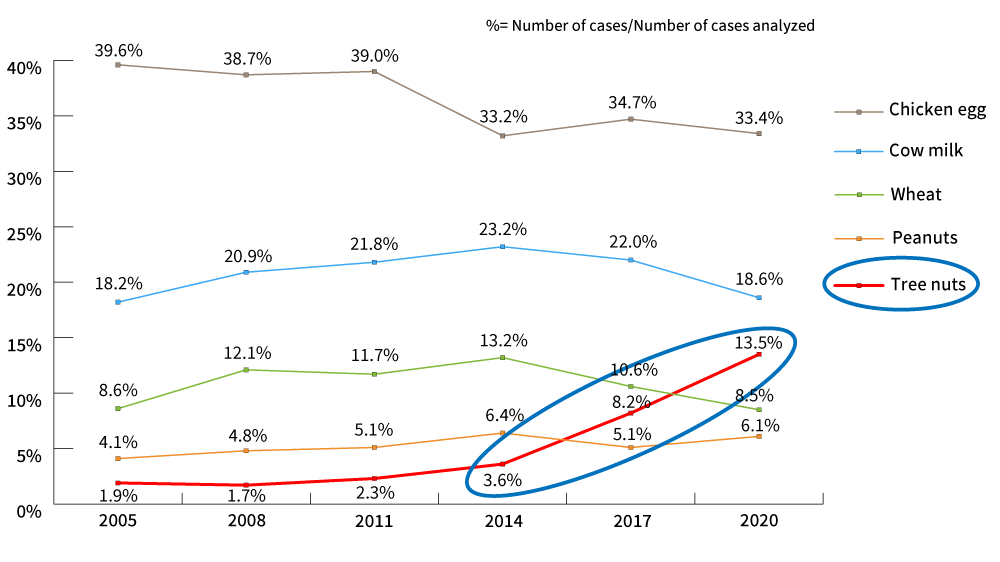
Looking at the increasing trend of nuts since 2005, while chicken eggs, cow milk, and wheat, which are high-ranking items, have remained almost unchanged, nuts have increased since 2014.
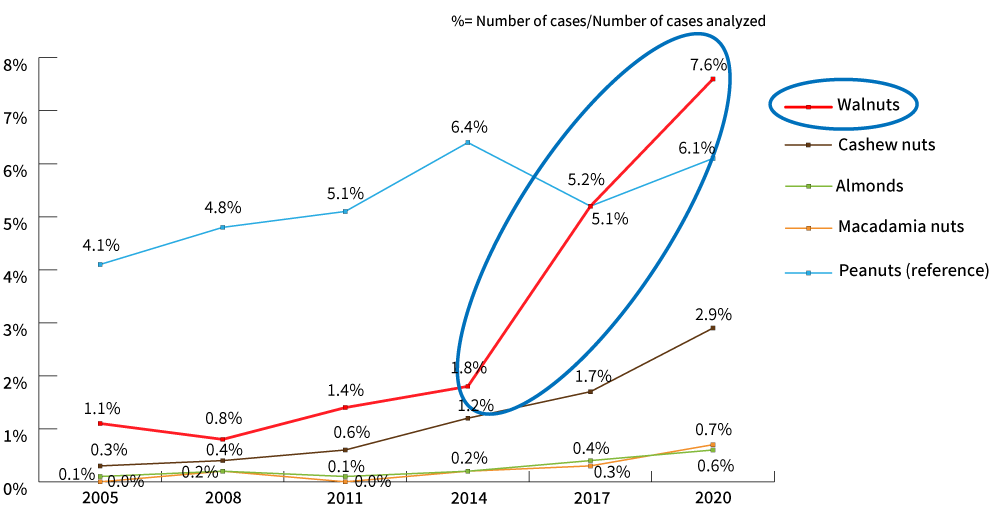
(Only tree nuts with more than 0.5% extracted in the 2020 survey)
Looking at the breakdown of nuts, the increase of cases by walnuts is remarkable.
- The number of survey cases this time was 6,080, keeping an increasing trend from the previous survey (4,851 cases).
- Until the previous survey(2017), the top three causative foods were chicken eggs, cow milk, and wheat, but in this survey, the proportion of nuts increased to third place surpassing wheat.
- Among nuts, allergens caused by walnuts have increased significantly, followed by cashew nuts.
- In terms of causative foods for first-time cases of allergy reaction onset, chicken eggs, cow milk, and wheat were the most common in the 0-year-old group, while tree nuts were among the top three in the infant and school-age groups.
- The increase in tree nuts as causative foods for immediate-type food allergy is not a temporary phenomenon.
Based on the above, as the conclusion of “-need to confirm whether or not the number of cases is just not temporary” for walnuts, walnuts will be added to the list of specified ingredients for mandatory labeling because they are considered to be “significantly increasing and not a temporary phenomenon”.
Future schedules
CAA plans to consult with the Consumer Commission on the revision of Food Labeling Standards, by the end of this fiscal year at the latest. In addition, with regard to “Development and validation of test methods”, which had been previously considered as an issue to be considered, development is currently underway with aiming of its completion in the next fiscal year. Therefore, it can be assumed that Food Labeling Standards will be revised by the end of March 2023, and walnuts will be changed to items subject to mandatory allergen labeling.
In the meantime, I would like to recommend those who are involved in food labeling read this report of investigation results. In addition to walnuts, the increase in cashews can also be reconfirmed, as well as the proportion of first-time cases of allergy and erroneous food intake, and the proportion of cases of food labeling errors among erroneous food intake. We hope that it will be utilized for future confirmation work.
References
- The 67th Food Labeling Section Meeting
- Regarding labeling of foods containing allergens
- Report on the national fact-finding survey of health damage caused by immediate-type food allergy in 2021
Share/Like/Follow:
Newsletter Signup
We issue monthly e-newsletters, which provide you with the latest updates on food labeling/regulations in Japan.
If you want to make sure to not miss any issue, please click below.
Related Service
Research Services on Ingredients & Food Labeling -For the Japanese Market-
We verify the conformity of ingredients and additives with the standards for use in Japan based on specifications such as formulation lists. We also verify the conformity of the proposed labeling of ingredient names, nutrients, etc. with the labeling standards based on specifications such as formulation lists.

Label bank Co., Ltd. CEO (Founder)
Born in Japan. Working on solving various issues related to food labeling operations. Also regularly gives lectures for various organizations in Japan.
Co-author of ‘Latest edition: Guide book Food Labeling Law and related business practical points – from scratch (Japanese version only)’ (DAI-ICHI HOKI CO., LTD/2019).



